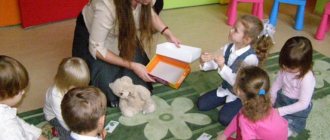Features of mental retardation and connection with speech
All this indicates a slow rate of mental development (PDD). The disease has become quite common, which indicates the relevance of the topic of speech development in children with mental retardation, which suffers greatly.
Slow development should not be confused with incorrect and poor-quality work of parents and preschool teachers. There is a noticeable lag in the following parameters:
- memory;
- attention;
- thinking;
- emotional health.
At school, teachers can see how students with mental retardation do not show interest in the life of the class, do not participate in the lesson and do not pay attention to the teacher’s questions. Any difficulties lead to immediate cessation of activity. Children quickly get excited if they are interested in something, but they also quickly “burn out.” All this is accompanied by poor academic performance, but the meaning of grades does not play any role for the child.
All comparisons are made with accepted standards. Speech deserves special attention, since the deviation in children with mental retardation is most obvious.
Causes of delayed development
ZPR occurs in children for several reasons, which are divided into the group of biological and social.
Biological problems include problems during pregnancy that could affect the fetus. Of particular danger are poisoning by toxins, complications of toxicosis, infections and injuries. Hypoxia may occur in the fetus, asphyxia and injury during childbirth for various reasons. Prematurity and genetic predisposition are dangerous.
In the early stages of life, the developing brain and body are severely affected by:
- injuries;
- infections;
- operations;
- anesthesia and other damaging factors.
Social reasons include:
- lack of educational games and contact with people;
- unreasonable prohibitions;
- psychological trauma in early childhood and unfavorable upbringing conditions;
- overprotection;
- neglect;
- rudeness and despotism of parents.
Diagnosis of delayed development and the role of speech
The disease cannot be detected at birth and, most often, before entering kindergarten or school. It is difficult for parents to notice deviations due to the habit of their child’s behavior. He is physically and externally healthy. Emotional lag may not cause much concern, since it is believed that the baby still has to learn everything (talk, play with children).
The inability to learn new things is noted by teachers at school. But speech disorders, which often accompany mental retardation, are detected much earlier.
A preschooler’s speech is normally sufficiently developed, as is his knowledge and vocabulary, which allows him to freely communicate on any topic that he understands. Sentences are developed, interconnected and filled with the main parts of speech: verbs, pronouns, adjectives, numerals and connecting words. They are correctly connected with each other: declension, conjugation, alternation of sounds and inflection. All this is learned through communication, but not in a child with mental retardation.
Speech dysfunction is not an immediate symptom; rather, it is a consequence of delayed development. The fact is that speech is the result of thought processes that are disturbed in the patient, which means there will be problems with the speaking process. The quality of speech shows the quality of knowledge and development.
Problems arise with both impressive and expressive speech. Sensory or impressive speech is responsible for perception and understanding. If the sensory zone of the cerebral cortex, where sound images of words are stored, is disrupted, a person will hear them, but not understand them. Thus, he becomes “deaf” to speech with normal hearing.
Expressive speech also has a second name - motor. She is responsible for reproducing words. When impaired, a person utters only an unintelligible set of sounds, but at the same time understands what is being said to him. If problems are detected, it is necessary to undergo a speech examination.
With mental retardation, both forms are equally impaired, and systemic underdevelopment of speech occurs, although there are cases when one of the options predominates. The following speech characteristics are noticeable in children:
- incorrect sound reproduction;
- poor vocabulary;
- grammatical errors.
They perceive speech slowly by ear, do not understand the meaning of individual words, as well as the meaning of intonation.
It is worth paying attention if the baby speaks in primitive sentences. Not a good signal if there is no understanding of generalized words, for example, furniture, fruit, transport. The inability to conduct a monologue and difficulties with dialogical speech are also symptoms of speech impairment in mental retardation. If you look at pronunciation, the worst are hissing and whistling sounds; the overall functioning of the speech apparatus is sluggish.
It may be that the dysfunction is not very noticeable, since the child’s abilities cover everyday problems, but impairments in understanding speech, logic and grammar can still be noticed.
Many studies have established that mental processes - attention, perception, memory, thinking, imagination - are mediated by speech. Deviations in the development of speech negatively affect communication with others, delay the formation of cognitive processes and, in this regard, prevent the full formation of personality [1].
In this regard, it is extremely important that a person has the ability to speak correctly and fully use his speech abilities in society. This can be hindered by the recently widespread disorders and deviations in speech development, in particular in sound pronunciation. The reasons for these deviations may be different. Conventionally, they can be divided into congenital and acquired
Sound pronunciation is a complex process of the formation of speech sounds, carried out by the energetic (respiratory), generator (voice-producing) and resonator (sound-producing) departments of the speech apparatus under regulation by the central nervous system.
For normal sound pronunciation, it is not enough for a child to master the system of phonemes of the language, phonemic perception and have sufficient mobility of the organs of the articulatory apparatus. He also needs to use the rules of phonotactics, that is, use phonemes taking into account the various phonetic conditions of their implementation.
A child’s acquisition of his native language follows a strict pattern and is characterized by a number of features common to all children. In ontogenesis, a child learns the laws of language “on the basis of a partial analysis of the speech of adults and on the basis of the innate cognitive tendencies of the child’s mind.”
Mental retardation (MDD) is one of the most common forms of mental pathology in childhood. More often it is detected when the child begins studying in the preparatory group of a kindergarten or at school (7 - 10 years old - a period of great diagnostic possibilities). The term “delay” emphasizes the temporary (discrepancy between the level of mental development and the child’s passport age) and at the same time the temporary nature of the lag itself, which is overcome with age, and the more successfully the earlier special conditions for learning and
Children with mental retardation have a low (compared to normally developing peers) level of perception development. This manifests itself in the need for a longer time to receive and process sensory information. Children with mental retardation do not always recognize and often mix letters of similar shape and their individual elements; combinations of letters are often mistakenly perceived.
At the stage of beginning systematic learning in children with mental retardation, inferiority of subtle forms of visual and auditory perception, insufficiency of planning and execution of complex motor programs are revealed.
Children in this group also have insufficiently formed spatial concepts: orientation in spatial directions for a fairly long period is carried out at the level of practical actions; Difficulties often arise in spatial analysis and synthesis of the situation.
Researchers note that the most characteristic features of attention for children with mental retardation are its instability, absent-mindedness, low concentration, and difficulty switching.
Children with mental retardation have uneven and slow development of sustained attention, as well as a wide range of individual and age differences in this quality. There are shortcomings in analysis when performing tasks under conditions of increased speed of material perception, when differentiation of similar stimuli becomes difficult. The complication of working conditions leads to a significant slowdown in task completion, but the productivity of activity decreases slightly [2].
Another characteristic sign of mental retardation is deviations in memory development. A pronounced lag and originality is also revealed in the development of the cognitive activity of these children, starting with the early forms of thinking - visual-effective and visual-figurative. Children can successfully classify objects according to such visual features as color and shape, but with great difficulty they identify the material and size of objects as general features, they have difficulty in abstracting one feature and consciously contrasting it with others, in switching from one principle of classification to another. When analyzing an object or phenomenon, children name only superficial, unimportant qualities with insufficient completeness and accuracy. As a result, children with mental retardation identify almost half as many features in an image as their typically developing peers.
Children with mental retardation also have a reduced need to communicate with both peers and adults [3]. Most of them exhibit increased anxiety towards the adults on whom they depend. Children almost do not strive to receive from adults an assessment of their qualities in a detailed form; they are usually satisfied with assessment in the form of undifferentiated definitions (“good boy”, “well done”), as well as direct emotional approval (smile, stroking, etc.).
It should be noted that children, on their own initiative, extremely rarely seek approval, but for the most part they are very sensitive to affection, sympathy, and friendly attitude. Among the personal contacts of children with mental retardation, the simplest ones predominate. Children in this category have a decreased need to communicate with peers, as well as low efficiency of their communication with each other in all types of activities [4].
Having studied the characteristics of the term “mental retardation”, it was indicated that this is a borderline form of intellectual disability of a preschooler, personal immaturity, a mild impairment of the cognitive sphere, a syndrome of temporary lag of the psyche as a whole or its individual functions (motor, sensory, speech, emotional, volitional). The term “delay” emphasizes the temporary (discrepancy between the level of mental development and the child’s passport age) and at the same time the temporary nature of the delay itself, which is overcome with age, and the more successfully the earlier special conditions for the education and upbringing of the child are created [5].
Children with mental retardation have a slow rate of speech development, its qualitative originality and a high prevalence of speech disorders. They have disorders of both impressive and expressive speech, disorders of oral and written speech, and inferiority of not only spontaneous, but also reflected speech. The impressive speech of these children is characterized by a lack of differentiation of speech-auditory perception, speech sounds, and sound pronunciation. Summarizing all that has been said, it can be noted that speech disorders in mental retardation are complex and at the same time differentiated in nature. The high prevalence of speech disorders in children with mental retardation necessitates their further in-depth study and identification of ways to increase the effectiveness of correctional interventions [6,7].
The method of E.F. was chosen as the basic scheme for examining children with mental retardation. Arkhipova. When compiling the methodology for the ascertaining experiment, materials presented in the manuals of O.V. were used. Eletskoy, A.A. Tarakanova; O.V. Eletskaya, E.A. Loginova, G.A. Penkovskaya, V.P. Smirnova, A.A. Tarakanova, S.M. Timakova, D.A. Shchukina [8,9].
The method of ascertaining experiment consists of several parts:
1. Study of the possibility of isolated sound pronunciation (group of whistlers).
2. Study of the possibility of pronouncing a sound (a group of whistlers) in syllables of different constructions.
3. Study of the possibility of pronouncing sounds in words in different positions in relation to the beginning, end, middle of the word.
4. Study of the possibility of pronouncing sounds in words of different syllabic structures.
5. Research on the possibility of pronouncing a sound in a sentence.
It can be assumed that this technique will make it possible to determine the characteristics of sound pronunciation disorders in children with mental retardation, identify deviations in the development of the process under study, and on this basis determine ways to correct them.
General actions for speech impairment due to mental retardation
When performing correctional work, it is important to take into account not only approaches to speech correction, but also the complex development of the child. ZPR for social reasons arises due to the constant pressure of some factor. Therefore, it is necessary to remove it, be it due to parental quarrels, inattention or severity. A child should grow up in peace.
Next, you need to create conditions in which he will learn something new. This will require the attention and time of parents, but will gradually raise the emotional and intellectual level.
Attention is paid to the speech characteristics of children with mental retardation and individual parameters are developed. For example, memory. If the child’s abilities allow, then you need to memorize short poems. This promotes understanding of narrative coherence, which is good for sensory language.
If there are problems understanding the meaning of words, then the emphasis is on explanation. Before requiring a child to use a new unfamiliar word, you need to show in practice what it means or how it works.
If you have problems with pronunciation, a series of speech therapy exercises is required.
To help your baby start speaking, you need to create a special environment. He must have an incentive to speak. To do this, you need to give as much material and content as possible so that there is something to talk about.
How to teach children with mental retardation
It is believed that it is better when children with problems are taught in special correctional institutions, or in separate classes in regular schools. But now the integrated learning method is being introduced, that is, children with mental retardation learn together, interacting with peers. Each method has its positive and negative sides.
| Special centers | Regular schools |
| Positive factors | |
| Individual approach to the child | There is an opportunity to freely communicate with other children |
| Specially trained specialists | The child is oriented and sees the results of others |
| Lack of negative social experiences and pressure | There is a lot of new things - there is active cognitive activity |
| A competent program for working with children with mental retardation | Regular schools are everywhere |
| Negative sides | |
| Often, such establishments are not cheap. | The program is not tailored to individual needs |
| Correction centers are not available in all cities; | The teacher is not focused on working separately with the “lagging behind” |
| There is no educational contact with children who have mastered speech | The child is not protected from pressure from children |
When working on coherent speech in children with mental retardation, a teacher at any institution will have to devote additional time to repeating the material, using visual teaching aids and cards. But with severe forms of delay, the achieved result will be temporary, which is why an individual approach remains a priority.
When teaching, the material is presented in very measured doses, in small portions. Only when one stage is mastered does the complication begin. Memorization requires practice. Therefore, they often use switching from one type of activity to an adjacent one, where they can repeat or use what they have learned.
Due to rapid fatigue, classes alternate with breaks every half hour. The material for the lesson is selected in such a way as to arouse interest and emotional excitement. This requires games. The teacher's tone should be inviting and soft. It is necessary to praise the baby for successes in order to evoke a positive response.
The most common mistakes parents make that lead to problems
Parents must have unconditional emotional acceptance of the child, despite the characteristics of children with mental retardation. When the needs for safety, love and care are met, emotional closeness with family members arises. Against this background, there is a desire to be in the company of other people and create warm and trusting relationships. It is necessary to pay attention not only to health and nutrition, but also to mood, needs, and contact with the baby.
You shouldn't wait until four or five years old to see a speech therapist for sounds. Correcting speech delays needs to be addressed at an earlier age, and is done somewhat differently than correcting incorrect pronunciation. The absence of corrective measures will lead to the fact that speech delay will develop into general speech underdevelopment, which entails a lag in the child’s development and a stable decline in intelligence.
Some parents do not want to go to these classes, not realizing that not only classes with a speech therapist and drug treatment, but also correctional programs and a well-structured psychotherapeutic environment will help solve/cure the problem.
Children with mental retardation require treatment, which begins with the introduction of correct guidelines into the communication strategy of their parents. Incorrect parental behavior in such cases worsens the already unfavorable environment for the child’s development. We must remember that the social and age-related crises of the family should not affect the child. The baby is drawn to adults and will be more intellectually similar to the parent with whom he communicates more intensely and whom he imitates.
How to develop sound pronunciation and speech understanding
Formation of speech in children with mental retardation is a long process. To correct and encourage the development of phonemic hearing and sound pronunciation, not only a number of exercises are required, but also preparation for them.
An articulatory warm-up is done; breathing exercises and fine motor skills exercises (for example, finger exercises) are also recommended. Such games can be accompanied by fairy tales, pictures, poems, and music.
After charging comes the main block of exercises. To develop understanding of speech, exercises with cards are used. There are several options. For example, a child might pick up a card that shows a sound that was said. Or show a word that has the specified sound. You can suggest choosing pictures that begin with the same letter.
A useful exercise is a game in which participants take turns saying words, but so that the first letter of the word coincides with the last letter of the word of the previous participant.
To correct speech, it is necessary to visit a speech therapist, who will teach you how to pronounce sounds correctly, and not just identify them.
How to develop grammar and vocabulary
To learn vocabulary and grammar, a child needs to master the patterns of language, phrasal speech, which is done in the process of communication, so there is no need to resort to rules and formulas, at least while the child is small and the school curriculum does not require this. Usually it is worth starting in 2nd grade.
You can learn to use endings correctly and agree on verbs in communication, gradually creating grammatical algorithms. The emphasis is on enriching vocabulary. To do this, you can ask the child to say the name of the object in the picture, and then come up with a story with it. The teacher provides assistance in this to ensure an interesting and emotional game.
Writing stories will also help with the formation of logical sentences and phrases. For the development of coherent speech, dramatization of fairy tales, games with proverbs and riddles are useful.
At any age, both schoolchildren and preschoolers must be taught to read. The volume of educational texts should not be large; it is convenient to place them on a card. The lower the reading skill, the less text on the card, down to individual syllables.
It is recommended to retell what you read using pictures, a plan, questions or without prompts. A more complex reverse option is to offer a picture or plan according to which the story is compiled.
Diagnosis and examination
Diagnosis of speech development delay is carried out by the following specialists:
- A neurologist will help you cope with diseases of the nervous system that underlie the defect.
- The pediatrician diagnoses and treats physical illnesses that could be contributing to the speech delay.
- A defectologist works with children on speech correction and the development of higher mental functions starting from the age of three. Classes are aimed at developing speech, thinking, memory, attention, fine and gross motor skills.
- A speech therapist will help stimulate speech development, master correct speech breathing, articulation of sounds, teach you how to control your speech, formulate thoughts and statements, and master vocabulary and grammatical forms. Classes can begin from 3–3.5 years.
- An educational psychologist establishes a diagnosis of mental retardation in children of primary school age or preschoolers based on special tests.
A neurologist may prescribe MRI, electroencephalography, computed tomography, neurosonography to exclude a lesion in the brain.
You can independently conduct a primary diagnosis of speech problems in a 3.5–4.5 year old child by observing him and conducting simple tests:
- To find out whether the child understands the meaning of words, you can say the names of objects in the immediate environment without looking at them, and offer to show them.
- To determine the understanding of the meanings of adjectives, you need to show two identical objects of different colors and ask: “Where is the red (ball)? Where's the blue one?
- To find out whether the baby understands verbs, you can show 2-3 pictures where the same character performs different actions, ask: “Where (the bird) flies, pecks, sits?”
- To determine the understanding of the meanings of prepositions, invite the child to put a toy or pencil on the box, in the box, behind the box, in front of the box, under the box.
- To find out whether the child uses grammatical categories correctly, he is asked to name the word in the plural (this is a hand, and this is... hands), create a diminutive form of a noun (the giant has legs, and the gnome has... legs), change the verb according to gender (the dog ran away, and the dog... ran away).
- To determine the state of phrasal speech, suggest finishing the started sentence about the object depicted in the picture (the girl... bought bread in the store, the boy... is riding home on a bicycle).
- To determine the ability to preserve the picture of a word, they are asked to repeat after an adult words consisting of 3-4 syllables: samovar, hammer, policeman, excavator, dandelion, ran across, etc.
conclusions
Don't ignore early signs that your child is having difficulty understanding or producing speech. Attention is paid not only to the correctness of sounds, but also to the logic of the narrative, speed and compliance of the level of speech with standards at a certain age.
Defects are easier to fix when they are not running. This is done both with the help of specialists and at home, because the process of learning and correction is a game and live communication. If you have patience and desire, every adult can work with a child.
Work should be based on games and regular repetition of even the smallest details. The process of cognition and learning should not end, because it is multi-stage. There will always be areas where you can improve or make the task more difficult. During classes, the child should feel comfortable, the material should arouse his interest, but not negative emotions.
Non-drug treatment
A necessary condition for the success of treatment is the inclusion of non-drug methods, which include:
- classes with a speech therapist;
- massage;
- exercise therapy;
- sessions with a psychologist;
- short-term sessions of individual psychotherapy for 1 hour 2 times a week after 3, 6, 12 months;
- dolphin therapy;
- occupational therapy;
- hippotherapy;
- acupuncture;
- magnetotherapy.
For treatment to be effective, a trusting relationship, mutual understanding and proper contact should be established between the child and the specialist. You can use family and behavioral psychotherapy.
The following exercises and tasks are used to develop speech:
- Teach your child to talk about the image in the picture. There is no need to change pictures often. It is advisable to gradually increase your vocabulary by describing the same picture.
- It is emotional to tell a child a story, making him want to imitate you.
- Read a short, interesting story and ask to retell it.
- Learn poems, nursery rhymes, and songs together.
- Communicate with the baby as much as possible, while trying not to understand his gestures, but insist on pronouncing sounds, syllables and words.
- Show the child the images, ask them to arrange them sequentially and make up a story.
- Constantly enrich your child’s vocabulary.
- Learn to speak in a monologue, and in the future - maintain a dialogue.
- Try together to describe, compare, teach to generalize events and natural phenomena.
One of the most basic conditions for achieving success is that a child should be interested in playing and learning. During joint classes, the atmosphere should be friendly.
Children with mental retardation have difficulty maintaining attention, quickly lose interest in a task, get distracted, and often cannot complete the game. This affects speech development, so you need to show tact and patience. The duration of classes should increase gradually.
Several exercises for home exercises to correct mental retardation:
- Guess who. Hide toys or pictures of animals and invite them to look for them, while imitating their voices.
- Guess the toy. Scatter toys around the room, offer to find one of them, naming only its signs.
- Parts of the whole. Show a picture or toy, naming parts of the object (nose, eyes, ears, head, neck, arms, legs, torso, tail), ask to repeat after the adult.
- Which? Consider five familiar toys or household items. Guess and take them out of a box or bag, then invite the baby to describe them, naming the color, shape, surface, taste, etc.
- Call me kindly. Show a picture of a large object and offer to name the same small object affectionately.
- What is missing. Show pictures that show objects with missing parts (a ball without a thread, a flower without a stem, a flag without a stick).
- What didn't happen? Show first three toys, then more, invite the baby to close his eyes, remove one and then name the one that disappeared, remember where it was, return it to its place, then switch roles.









